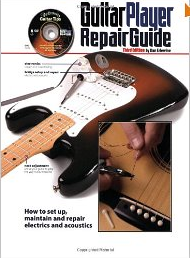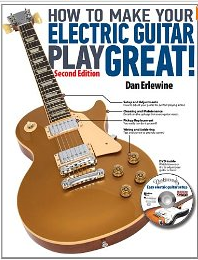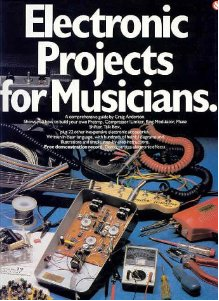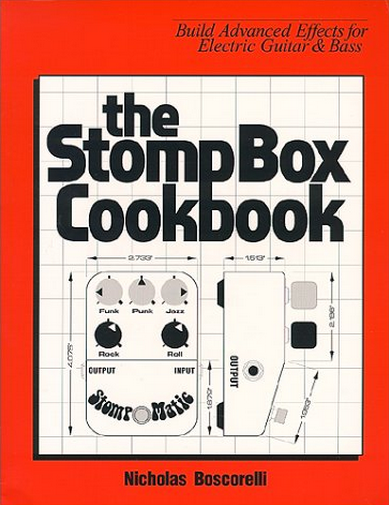Monday: Theory and Technique
Tuesday: Gear
Wednesday: Repairs and DIY
Thursday: Biography
Friday: Fiction
Tonefiend Book Week is simple: I discuss a few titles I’ve found particularly enlightening, useful, or entertaining, and then you jump in and do the same. I’ve organized the days of this week by subject matter. Today’s topics are repair and DIY.

I’m indispensable.
Sorry in advance if my faves in this category are a bit predictable!
For any repair topic, I turn to the redoubtable Dan Erlewine. Dan knows his stuff like no one else, plus he’s a terrific writer, with a rare talent for explanation and a charming sense of humor.
Dan has serviced the instruments of countless great players. (I’d insert a list, but it might wear out my comma key.) Better yet, he makes comprehensive notes and measurements. You learn much about, say, Albert King, just by studying Dan’s numbers.
Now, I’m the furthest thing from a guitar tech. (Just ask San Francisco’s brilliant Gary Brawer, who regularly rescues my guitars from clumsy abuse and ill-considered DIY attempts.) But for players who simply need help with basic setup, maintenance, and modification tasks, Erlewine’s books — The Guitar Player Repair Guide and How to Make Your Electric Guitar Play Great — are godsends. Get ’em both. You won’t be sorry. (The digital versions live on my iPad for workbench reference.)

I’m indispensable too!
I never had the pleasure of editing Dan’s columns when I worked at Guitar Player — Jas Obrecht jealously guarded that privilege. But the entire staff would laugh itself silly over Dan’s April Fools columns, like the one where he explained how to install a Floyd Rose tremolo on a pre-War Martin. (If I recall correctly, the process involved filling the body with cement.) Another year, he suggested using kitchen objects as lutherie tools. The photos included a kitchen table used as a clamp for a glue job on some über-valuable axe. (Touch of genius: The pic showed the poor guitar being crushed by a weighty trestle table, where Dan’s kids sat enjoying large bowls of breakfast cereal.) That one prompted a very famous guitar maker to write a shrill letter to the editor. (“It’s highly irresponsible for Mr. Erlewine to recommend using a heavy kitchen table as a clamp. Proper clamps don’t even cost that much!”) The luthier followed this with a frantic phone call, explaining that someone had alerted him to the joke, and begging us not to run the letter. We didn’t. (Dagnabbit!)
Recommending DIY books is trickier. I don’t know anything about “build your own guitar” books, though perhaps some smart readers can offer suggestions. I’ve made a few cool amps, but only from kits, and only using the supplied instructions. (Anyone have recommendations here?) But I have built a buttzillion guitar pedals, and I’ve surveyed most of the book options.
One title is an undisputed classic: Craig Anderton’s Electronic Project for Musicians. Anderton’s magnum opus pretty much spawned the DIY effects movement — many, if not most, modern pedal builders got their start here. Some of these projects still sound great, and to this day builders borrow Craig’s ideas (especially his CMOS-based Tube Sound Fuzz). If you’re passionate about DIY effects, you should own this. You probably already do.

Crucial, but dated.
But…the book hasn’t been revised in over 20 years, and much has changed. New parts…new component nomenclature…new designs…new hardware options. You can still harvest cool ideas here, but I can’t recommend it as a starting point for DIY adventures today.
(And why, you may ask, doesn’t Craig revise this book? The dude has a lot on his plate! I hung out with Craig at Musikmesse last month, where he told me he’s moving to Nashville to assume a major role at Gibson. Man, Craig has done so much for our community: popularizing DIY, developing Electronic Musician magazine, penning hundreds of Guitar Player articles, and writing half the gear manuals on your studio shelf. Thanks, Craig!)
Another interesting but dated resource is Nicholas Boscarelli’s Stompbox Cookbook. It’s been out of print since the Pleistocene, and used copies fetch $100 or more. You can probably find illicit copies online. But is it worth stealing, or buying at unconscionable prices? Probably not. (I own a copy, and while some of the circuits are cool, it’s not all that. You can find better and more complete info elsewhere.)
Additional options include the e-books of Nashville pedal guru Brian Wampler. These seem to be out of “print,” but you can probably find copies if you search around. But while Wampler has some cool tips, most of the resources in this books are borrowed from various DIY stompbox sites.
Which brings me to my ultimate DIY stompbox book recommendation: none.
Instead, start by building a few kits from vendors such as BYOC. Haunt the forums at DIY Stompboses and Freestompboxes. Read the fantastic and free articles at Gauss Markov, Runoff Groove, and Beavis Audio Research. (And if you’re feeling lucky, check out what this clown has to offer.) When books fail, the web prevails!
How about you guys? Who do you turn to when you break something — or when you want to build something to break?









I’ve had the Craig Anderton book for more than 25 years. He published another one in 1995 – yes, a long time ago also – called “Do it Yourself Projects for Guitarists” which I think is great and can in some ways be considered an update of the other.
One big improvement that makes life much easier for us DIYer’s is he now uses common IC’s like NE5532 or TL072 (8 pin) for double op amps, instead of the weird 4739 (14 pin) of the first book; so weird, in fact, that I took myself the trouble of redoing all schematics and printed boards layouts of the projects I was interested in (quite a few of them) to use the TL072 instead of the original 4739. But in those times of old, I didn’t have kids and I was not married.
The tube sound fuzz is really great. One of the most musical fuzz boxes I’ve had. And I still have around the Phase Shifter (project 21) controlled by the Envelope Follower (project 25), all in the same box (actually, all in the same PCB, plus the IC switch – boy, did I have time then), though it needs to be revised some day, because it’s not working… some day.
Many of these projects have been updated for modern parts by various third parties. Just google the project name + schematic.
Example: https://www.beavisaudio.com/bboard/projects/bbp_RedLlama.pdf
Thought you would be interested.
:thumbup:
+1 million for Anderton. That envelope controlled phase shifter was my favorite out of all of them though I never built it. I still remember the little lick from the plastic sound sheet. I met Craig in the elevator at a NAMM show once and made a complete idiot of myself salivating upon his royal presence. Some day I may mention the time I “met” Larry Hartke and who I presume was his wife in an elevator at NAMM.
Another +1 million for Hal Chamberlin’s “Musical Applications of Microprocessors”. I’m sorry, as usual I am off topic as this last one has nothing to do with DIY or the guitar, but without that book, I never would have understood what it took to make a MIDI controllable analog system and would not have had the opportunity to develop these for a few years professionally.
As far as guitar repair goes, sadly I am really bad at it and scared to anything beyond changing strings.
I think the vast majority of my diy ‘reading’ is online. There are tons of great sites (just google diy ‘x’). I think that the aforementioned Beavis site and RG Keen’s (https://www.geofex.com/) are two great places to get general circuit starting info. TDPRI has a ton of well documented guitar builds.
Nice Noise (https://windworld.com/products-page/books-cds/nice-noise-preparations-and-modifications-for-guitar/) is on my to-buy list.
Man, where do you find this stuff?
I just ordered a copy of Nice Noise. I’ll share my impressions after I check it out.
Keen is great — one of the real wizards. But damn, Beavis is the best/funniest writer on the topic. His site is worth reading in its entirely just to savor his sense of humor. I prefer my technology served with good graphics, taut prose, and quality yuks.
cool. I’m really looking forward to that book. It just came out a couple months ago so I’ll pick one up next time I’m stateside. I’ve got a couple decent beaters ready to try some of the more drastic mods.
Someone asked the question:
https://knowyourmeme.com/memes/fucking-magnets-how-do-they-work
Dan has the answer!
https://www.youtube.com/watch?feature=player_embedded&v=Dj8CalXjNUc
Ooh, I like the sound of the ‘Nice Noise’ book. That’s pretty cool they let you read an 18 page preview and also have a link to let you hear audio examples (60 of them!) on SoundCloud.
I personally love this book – Handmade Electronic Music: The Art of Hardware Hacking – Nicolas Collins (Amazon):
https://www.amazon.com/Handmade-Electronic-Music-Hardware-Hacking/dp/0415998735/ref=sr_1_1?s=books&ie=UTF8&qid=1370466718&sr=1-1&keywords=handmade+electronic+music
Don’t be put off by the title. If you enjoy the making the projects in the DIY section, and maybe already bought the ‘MAKE: Electronics’ book too, this is an excellent book (with DVD) to add to your library. Some of the DVD files are available to watch on the author’s own site too which is also worth a look.
https://www.nicolascollins.com/hackingtutorials.htm
Off topic (but only slightly) – Some sites I’m currently looking at are:
For general weird guitar info:
https://www.guitarmoderne.com/about-page
and for pedal layouts:
https://tagboardeffects.blogspot.co.uk/
Thanks man! I’ve been eyeing that Collins book. I think you’ve sealed the deal for me.
The MAKE: Electronics books is fab, and the only reason I didn’t mention it is because it doesn’t focus on music (though it does include a simple fuzz circuit among its many project). Author Charles Platt is a great explainer with a nice, clear style.
https://www.amazon.com/Make-Electronics-Discovery-Charles-Platt/dp/0596153740/ref=sr_1_1?s=books&ie=UTF8&qid=1370467866&sr=1-1&keywords=make+electronics
Checking out those blogs is eye opening.
Maybe you know someone that is interested in the fundamentals of Audio and Music Engineering?
https://www.coursera.org/course/audiomusicengpart1
This may be too basic for most here, but it looks to be a great introduction to the concepts. I’m planning on digging into it. Plus, if you follow through with the course plans you will have built your own guitar practice amp by the time the session ends… 🙂
A DIY recording favourite of mine is ‘The Musician’s Guide To Home Recording’. Yes it’s getting on a bit (1993), but it‘s packed with useful information which is still valid even in today’s digital era. I had a quick look and it’s currently selling (used) on Amazon for $4.71 including shipping, you really are getting a lot of great information for the price. The EQ charts and guide to Mic placement and room acoustics are worth it alone.
https://www.amazon.com/Musicians-Guide-Recording-Mclan-America/dp/0825613787/ref=sr_1_1?ie=UTF8&qid=1370552892&sr=8-1&keywords=musicians+guide+to+home+recording